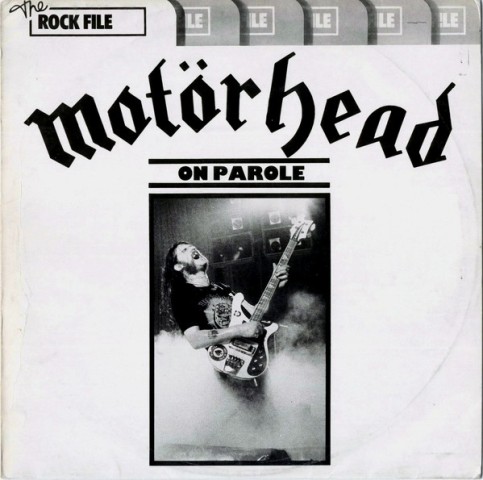Music Reissues Weekly: Motörhead - The Manticore Tapes | reviews, news & interviews
Music Reissues Weekly: Motörhead - The Manticore Tapes
Music Reissues Weekly: Motörhead - The Manticore Tapes
Snapshot of Lemmy and co in August 1976 proves fascinating

Manticore was owned by Emerson, Lake and Palmer and their manager. The organisation provided the name for the band’s label. Apart from ELP and its individual members, the best-known signees to the imprint were Italian prog-rockers PFM and former King Crimson member Pete Sinfield. Despite this new album’s title, Motörhead were not with Manticore.
However, Lemmy and co used ELP’s Manticore Studio in Fulham – in what used to be a cinema – during August 1976 when they showcased for prospective record labels. The release of the album they had recently completed for United Artists appeared to be cancelled and they were moving on. While at Manticore, Island Records’ head of A&R came to see them but didn’t sign Motörhead. They were also recorded. The Manticore Tapes is the first-ever release of what seems to be a previously unknown tape of them running through their repertoire at ELP’s base camp.
 At this point, Motörhead was Lemmy Kilmister (bass/vocals), Eddie Clarke (guitar) and Phil Taylor (drums). This was a different band to that which began recording the album for UA – the label Lemmy’s old band Hawkwind was on – at Rockfield Studios in September and December 1975. Then, it was Lemmy, former Pink Fairies member Larry Wallis (guitar/vocals) and Lucas Fox (drums). Fox was ousted from the band during the next set of sessions in January and February 1976 and replaced by Taylor who, after re-recording most of his predecessor’s parts for the album, first played live with the band on 5 March 1976.
At this point, Motörhead was Lemmy Kilmister (bass/vocals), Eddie Clarke (guitar) and Phil Taylor (drums). This was a different band to that which began recording the album for UA – the label Lemmy’s old band Hawkwind was on – at Rockfield Studios in September and December 1975. Then, it was Lemmy, former Pink Fairies member Larry Wallis (guitar/vocals) and Lucas Fox (drums). Fox was ousted from the band during the next set of sessions in January and February 1976 and replaced by Taylor who, after re-recording most of his predecessor’s parts for the album, first played live with the band on 5 March 1976.
Next, due the layers of overdubbed guitar in what was recorded, the band decided to add a second guitarist to fill out their live sound. In April 1976, they had a rehearsal with Eddie Clarke. Larry Wallis instantly bailed out, so the band continued as a three piece with just Lemmy remaining from the line-up which commenced the album. Wallis’ last show with Motörhead had been on 22 March 1976.
Which is where the fascinating Manticore Tapes comes in. Motörhead had acquired a manger named Frank Kennington. He had been a roadie for The Who in the early Seventies. Installing Motörhead at Manticore suggests Kennington had some money. What’s heard on the new release was recorded with Ronnie Lane’s mobile studio (booking this is further evidence of money floating around). This is not, as it is marketed, “the original ‘lost’’ album.” Instead, it exists in a hinterland between a rehearsal recording and a demo tape. Frustratingly, no information has been provided on where this tape was for close-to 50 years, how it was disinterred, whether it was a multi-track which has been recently mixed down or whether it represents a mix made in 1976.
 Despite being a mostly new Motörhead, songs recorded for the cancelled album were caught on tape (although UA passed on the album in 1976, it was issued in late 1979 as On Parole (pictured left): hence knowing the Wallis-period Motörhead’s repertoire). “Iron Horse / Born to Lose,” “Leavin' Here,” “Motörhead,” “Vibrator” and “The Watcher” had been tackled earlier at Rockfield. Looking back further, “Motörhead” and “The Watcher” were ported over from Hawkwind to Motörhead. On The Manticore Tapes, there are just two tracks which were not recorded at Rockfield – ostensibly, each was worked-up after Wallis had left: the then-recent arrivals are “Help Keep us on the Road” (aka "Keep us on the Road") and a cover of John Mayall’s “I’m Your Witchdoctor” (with "Leavin' Here," this is the second Sixties R&B track tackled by the band).The Manticore Tapes includes two takes of “Leavin' Here,” “The Watcher” and “Vibrator” (hardly the stuff of a “lost album” then). There is also what’s credited as “Instrumental,” a number later re-recorded in 1977 for the debut album proper but not issued at the time (it surfaced on the Beer Drinkers and Hell Raisers EP, as did a first-album version of “I’m Your Witchdoctor”).
Despite being a mostly new Motörhead, songs recorded for the cancelled album were caught on tape (although UA passed on the album in 1976, it was issued in late 1979 as On Parole (pictured left): hence knowing the Wallis-period Motörhead’s repertoire). “Iron Horse / Born to Lose,” “Leavin' Here,” “Motörhead,” “Vibrator” and “The Watcher” had been tackled earlier at Rockfield. Looking back further, “Motörhead” and “The Watcher” were ported over from Hawkwind to Motörhead. On The Manticore Tapes, there are just two tracks which were not recorded at Rockfield – ostensibly, each was worked-up after Wallis had left: the then-recent arrivals are “Help Keep us on the Road” (aka "Keep us on the Road") and a cover of John Mayall’s “I’m Your Witchdoctor” (with "Leavin' Here," this is the second Sixties R&B track tackled by the band).The Manticore Tapes includes two takes of “Leavin' Here,” “The Watcher” and “Vibrator” (hardly the stuff of a “lost album” then). There is also what’s credited as “Instrumental,” a number later re-recorded in 1977 for the debut album proper but not issued at the time (it surfaced on the Beer Drinkers and Hell Raisers EP, as did a first-album version of “I’m Your Witchdoctor”).
Listening to The Manticore Tapes is a curious experience. This is manifestly the Motörhead of their 1977 debut album: every element of the sound and the attack is there. But “Help Keep us on the Road” is messy and, overall, it is all less focussed, not quite as hard or hard driving and is taken little slower then the 1977-model band. Perhaps punk had not yet affected the band’s approach. That said, it is still plenty more tough than other bands playing the UK in the period. Furthermore, it feels as if Clarke was working from what had been recorded with Wallis and was finding his way. Which makes sense, as it is unlikely these tracks were ever meant to be heard as they were most probably recorded for reference only – Lemmy is heard talking, which supports this, as do some barely audible vocals on what are credited as instrumentals.
Still without a label, the Lemmy, Clarke and Taylor Motörhead played UK dates over August 1976 following their spell at Manticore. The next live shows were in November and December 1976, in the lead-up to a proposed band-produced single on Stiff Records. This didn’t happen as they were still contracted to United Artists (the single, “Leavin' Here” / “White Line Fever,” was released in France and Sweden in early 1977, pictured below right). Motörhead had now made two records which had not made it to shops. Hardly a boost for the band’s confidence.
 Tracking back a little, the curb the UA deal exerted on the Stiff single means it was unlikely that any label which did express an interest in August 1976 would have been able to sign the band anyway.
Tracking back a little, the curb the UA deal exerted on the Stiff single means it was unlikely that any label which did express an interest in August 1976 would have been able to sign the band anyway.
As is the modern way, there are multiple editions of The Manticore Tapes. The one sent for review is a single-LP version which, despite lengthy lists of credits on the inner sleeve for consultants, managers, for audio restoration and so on, lacks any proper annotation detailing what this is (a sticker on the cover says “from 1976, recorded at the legendary Manticore Studios”: this is as far it goes). Sloppy. The single LP has no liner notes. Using a new version of Joe Petagno’s illustration created for the 1977 release of the cancelled Stiff single is rum – the image was not associated with the band in 1976. There is also a double-LP version (not sent for review) with liner notes which teams the Fulham material with the oft-issued 3 June 1977 Birmingham Town Hall show – an OK-sounding audience recording of a blistering show first released as Blitzkrieg On Birmingham. Judging by the download sent, this sounds a bit better than previous releases. This configuration also includes a single containing two tracks recorded at Birmingham’s Barbarella's on 12 October 1977 (this was also not sent for review). Staggeringly, this set sells for just-short of £100. To be clear: this is two LPs, a single, each on white vinyl, plus what seems to be a bound-in booklet within in a hardback gatefold sleeve. It is marketed as a “super deluxe bookpack.” That is some price.
Although The Manticore Tapes initially seems be a completists-only release, it is more than this as it showcases the earliest-known recordings – in close-to studio quality – by the definitive line-up of one of the UK’s most idiosyncratic rock bands at a point when they had no peers and had not yet fully embraced heavy metal – that came after they signed to Bronze Records in 1978. It is a vital snapshot of a Motörhead which was trying to push forward but – at least in 1976 – was unable to do so. This was when Motörhead was still identifiably a freak-rock outfit with leanings towards Sixties R&B. Above all though, they were a hard rock band. One which was harder than any other.
- Next week: on his first solo John Peel session, Gary Numan puts Tubeway Army behind him
- More reissue reviews on theartsdesk
- Kieron Tyler’s website
Explore topics
Share this article
The future of Arts Journalism
You can stop theartsdesk.com closing!
We urgently need financing to survive. Our fundraising drive has thus far raised £49,000 but we need to reach £100,000 or we will be forced to close. Please contribute here: https://gofund.me/c3f6033d
And if you can forward this information to anyone who might assist, we’d be grateful.

Subscribe to theartsdesk.com
Thank you for continuing to read our work on theartsdesk.com. For unlimited access to every article in its entirety, including our archive of more than 15,000 pieces, we're asking for £5 per month or £40 per year. We feel it's a very good deal, and hope you do too.
To take a subscription now simply click here.
And if you're looking for that extra gift for a friend or family member, why not treat them to a theartsdesk.com gift subscription?
more New music
 Album: Josh Ritter - I Believe in You, My Honeydew
The alt-country singer's latest isn't consistent but does hit highs
Album: Josh Ritter - I Believe in You, My Honeydew
The alt-country singer's latest isn't consistent but does hit highs
 Album: David Byrne - Who is the Sky?
Born to be weird
Album: David Byrne - Who is the Sky?
Born to be weird
 Edinburgh Psych Fest 2025 review - eclectic and experimental
Underground gems and established acts in this multi-genre, multi-venue day long festival
Edinburgh Psych Fest 2025 review - eclectic and experimental
Underground gems and established acts in this multi-genre, multi-venue day long festival
 Album: Faithless - Champion Sound
Three decades into their career the perennial dance duo nail a lengthy but likeable set
Album: Faithless - Champion Sound
Three decades into their career the perennial dance duo nail a lengthy but likeable set
 Album: Saint Etienne - International
British pop institution’s final communiqué is an unalloyed winner
Album: Saint Etienne - International
British pop institution’s final communiqué is an unalloyed winner
 Album: Brad Mehldau - Ride into the Sun
A sincere tribute to Elliott Smith
Album: Brad Mehldau - Ride into the Sun
A sincere tribute to Elliott Smith
 Music Reissues Weekly: The Outer Limits - Just One More Chance
Exhaustive anthology unearths the full story of the Sixties mod-pop band from Leeds
Music Reissues Weekly: The Outer Limits - Just One More Chance
Exhaustive anthology unearths the full story of the Sixties mod-pop band from Leeds
 theartsdesk Radio Show 37 - Pete Lawrence of the Big Chill discusses the power of protest music and his new project This Is The Fire
Talking to cultural activist Pete Lawrence – camp outs, singalongs and saving the world
theartsdesk Radio Show 37 - Pete Lawrence of the Big Chill discusses the power of protest music and his new project This Is The Fire
Talking to cultural activist Pete Lawrence – camp outs, singalongs and saving the world
 Album: Sabrina Carpenter - Man's Best Friend
Short but not so sweet
Album: Sabrina Carpenter - Man's Best Friend
Short but not so sweet
 Album: CMAT - EURO-COUNTRY
The flame-headed chanteuse with the comic touch hits pop perfection
Album: CMAT - EURO-COUNTRY
The flame-headed chanteuse with the comic touch hits pop perfection
 Album: The Hives - The Hives Forever, Forever The Hives
No power ballads, no acoustic interludes - just speedy rock’n’roll all the way
Album: The Hives - The Hives Forever, Forever The Hives
No power ballads, no acoustic interludes - just speedy rock’n’roll all the way

Add comment